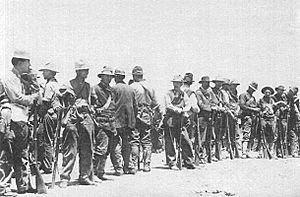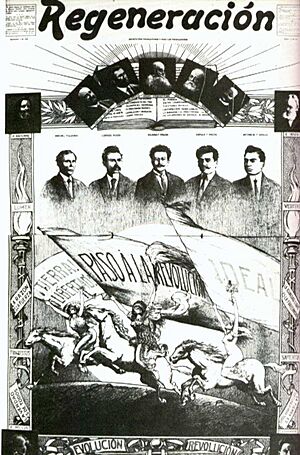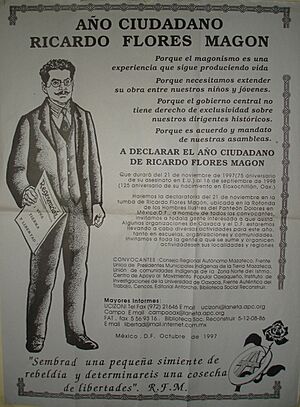Magonism facts for kids
Magonism (which in Spanish is called Magonismo) is a way of thinking about how society should be organized. It's a type of anarchism, which means believing in a society without rulers or a government. More specifically, it's a form of anarcho-communism, where people share everything and work together.
This idea was important before the Mexican Revolution of 1910. It was mainly based on the ideas of Ricardo Flores Magón, his brothers Enrique and Jesús, and other people who worked on the Mexican newspaper Regeneración. This newspaper was the voice of the Mexican Liberal Party. Important collaborators included Práxedis Guerrero, Librado Rivera, and Anselmo L. Figueroa.
Contents
Magonism and its Core Ideas
In the early 1900s, the Mexican government and newspapers called people who followed the Flores Magón brothers' ideas "magonistas." These ideas inspired people to overthrow the harsh rule of Porfirio Díaz and create a fairer society. The government tried to make these protesters seem like troublemakers to keep its image of peace.
However, the Flores Magón brothers and others in the Mexican Liberal Party (PLM) didn't like being called "magonistas." They felt they were fighting for a big idea, not for a specific leader or group. They first called themselves "liberals" because of their party name. Later, they called themselves "anarchists."
Ricardo Flores Magón himself once said, "Liberal Party members are not magonistas, they are anarchists!" This shows they didn't want to be seen as followers of one person. They believed in a society where everyone was free and equal.
Magonist ideas were shaped by many thinkers. Important anarchist writers like Mikhail Bakunin and Pierre-Joseph Proudhon influenced them. Other key influences were Peter Kropotkin's books, The Conquest of Bread and Mutual Aid: A Factor of Evolution. These books talked about sharing resources and helping each other. They also learned from Mexico's own history of liberal ideas and the way indigenous people governed themselves.
Magonism and Indigenous Communities

Since the Spanish conquest, indigenous peoples in Mexico have worked to keep their traditions. These traditions often included direct democracy, where everyone makes decisions together. They also practiced assembly meetings, rotated leadership roles, and protected shared land. They believed in mutual aid, which means helping each other in the community. These ideas were very similar to the anarchist principles that the magonists promoted.
The Flores Magón brothers learned a lot from their father, Teodoro Flores, who was a mestizo Nahua person. Other members of the PLM also spent time with indigenous groups. This happened during their organizing and uprisings between 1905 and 1910. They learned from groups like the Popoluca in Veracruz, the Yaqui and Mayo in Sonora, and the Cocopah in Baja California.
Fernando Palomares, a Mayo indigenous person, was a very active member of the Liberal Party. He took part in important events like the Cananea strike and the libertarian campaign of 1911 in Mexicali and Tijuana.
The Legacy of Magonism
After the main fighting of the Mexican Revolution ended, and after Ricardo Flores Magón passed away in 1922, people started to remember and study Magonist ideas again. Trade union members in Mexico and the United States were especially interested. Later, Mexican governments recognized the Flores Magón brothers as important figures who helped start the revolution.
The ideas of the "magonistas" were very important for the revolution that began in 1910. They also influenced the social rights written into the Mexican Constitution of 1917. They had been fighting and creating plans for economic and social change since 1906.
However, even with new laws, life didn't change much for many people. The "magonistas" believed they weren't fighting to change who was in charge, but to get rid of rulers altogether. Because of this, the surviving "magonistas" kept spreading their anarchist ideas. Librado Rivera was even put in prison. Enrique Flores Magón believed that "the Mexican social revolution is not yet over." He only felt safe during the presidency of Lázaro Cárdenas.
The Mexican Anarchist Federation, started in 1941, continued to publish the Regeneración newspaper. They helped keep Magonist ideas alive for about 40 years.
In the 1980s, Magonism was still important among some young anarcho-punk groups. A library in Mexico City, called Biblioteca Social Reconstruir, was founded in 1980. It had many anarchist books and works about Ricardo Flores Magón.
In 1994, the Zapatista Army of National Liberation (EZLN) in Chiapas said they were inspired by the Flores Magón brothers' ideas. In 1997, indigenous groups and others declared a "Citizen Year of Ricardo Flores Magón" in Oaxaca. This showed how important his ideas still were.
In August 2000, "Magonistas Days" were held to celebrate 100 years since the Regeneración newspaper was founded. Some groups involved in the 2006 popular uprising in Oaxaca were also influenced by Magonist anarchist ideals.
Images for kids
-
Magonistas in Tijuana in 1911
See also
 In Spanish: Magonismo para niños
In Spanish: Magonismo para niños






